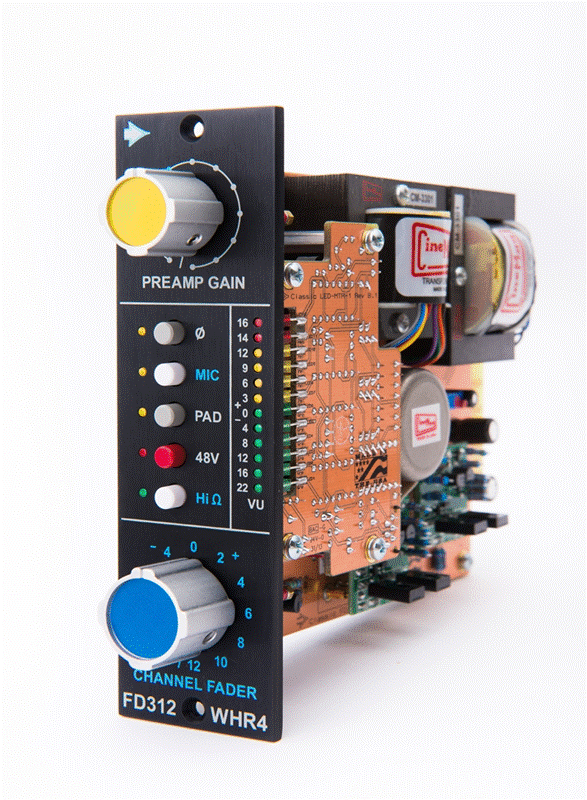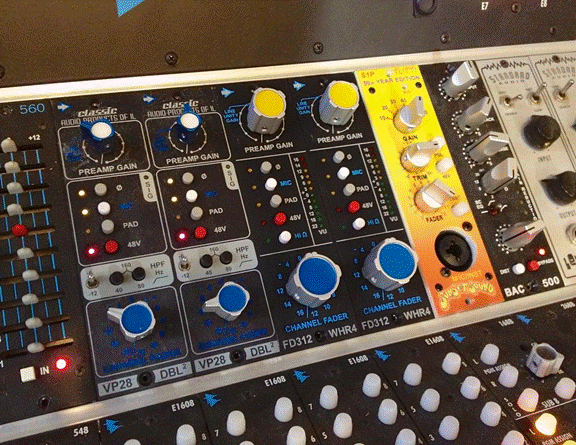In addition selling components to aid in the restoration,
repair and modification of API consoles, Classic API (Audio Products of
Illinois) has several 500 Series kits, the majority in the $175-275 price
range, allowing DIYers to build high-quality mic preamps at a fraction of the
price of fully manufactured units. Last fall, Classic API released the Heider
FD312, the only Classic API model not available in kit form, distributed
exclusively by Nashville’s Rack-N-Roll Audio. The Heider FD312 was modeled after
the preamps in the legendary Wally Heider Recording Studio 4 console that was
custom built by Frank De Medio in the early ’70s. These pres were built around
stock 312 cards that De Medio modified by replac-ing the stock input
transformer with a cus-tom-wound Ed Reichenbach RE-0887 trans-former which he
interfaced differently than the stock transformer; this resulted in a smoother,
more musical midrange. Utilizing Ed Reichenbach’s original notes and specs,
Cinemag builds the RE-0887 input trans-formers utilized in the Heider
FD312.Unfortunately, there is no instrument input on the Heider FD312, though
it includes both Mic and Line inputs. In Mic mode, the gain ranges from +22 dB
to +57 dB with an input impedance of 167 ohms; in Line mode, the gain ranges from
-14 dB to +21 dB with an input impedance of 9 kΩ.. While I’ve never found
myself looking for a line input on a solid-state pre, I’ve fallen in love with
the character of the FD312 when operating in Line mode. I’ve been running my
ITB mixes through two channels in Line mode set to unity, and I’ve found that
the pre adds loads of character to my mix with a smoother top end and improved
definition.

Classic Audio
Products of Illinois Heider FD312WHR4
In addition to the preamp circuit, the module employs an
active booster stage, providing up to 12 dB of gain - identical to the boost
circuit utilized in early- to mid-’70s API desks. As with other two stage mic
preamps, you can attain more color and harmonic content by increasing the
preamp gain and pulling back the Channel Fader, or a more pure tone by setting
the Channel Fader to unity or slightly higher and pulling the preamp gain back.

Classic API Heider
FD312 inside
Activating the Hi-Z function (nearly always my sonic
preference) increases the input impedance to 300 ohms and raises the gain by 3
dB. Activating the pad inserts a 16 dB pad and increases the input impedance to
765 ohms. All of these different impedance changes are wonderful as they
provide tons of creative options while dialing in a sound. The stepped channel
fader provides a final -16 dB to +12 dB gain stage, making the preamp’s maximum
gain 72 dB in Mic mode with the Hi-Z engaged, and 69 dB with the Hi-Z not
engaged. The FD312’s maximum output level is +29 dBu and it includes a
beautiful 12 segment, -22 to +16 VU meter that ranges from green (-22 to 0) to
yellow (+3 to +12) to red (+14 to +16) where 0 VU = +4 dBu.
I first used the Heider FD312 to record kick and snare on a
tracking session. The pre sounded fantastic; I found myself using substantially
less-than-typical EQ. On another tracking session, I used the pre on toms and
was blown away again. When it comes to recording drums, the Heider FD312 is
super. It’s punchy as hell, with tons of character, leaving nothing to be
desired. The pre also excels with acoustic instruments and vocals.
The best way I’ve found to describe the Heider FD312 is like
a classic API mic pre but better. It has all of the rich punch and clarity of
an API with a milky-smooth midrange that sounds as musical as any pre I’ve ever
encountered. The Heider excels on drums and electric guitars, but is equally
fit for recording vocals and acoustic instruments.
Summary
The Sonic Farm Silkworm, Electrodyne 501 and Heider FD312
are all three wonderful mic preamps. If this was a shoot-out, I’d have to call
it a three-way draw because they are all winners. All are packed full of character,
reasonably priced and fantastic performers. If you can afford it, I’d recommend
getting a pair of each. And, on the microphone front, MXL continues to impress
with its high-quality mics that are surprisingly affordable.
Next PAR, I’ll delve into Moog’s 500 Series Ladder Filter
and Analog Delay as well as some other surprises.

Heider FD312 Mic /
Line Preamp
Specifications
- MIC
Preamp Gain Range: +22dB to +57dB (+3dB with Hi Z engaged)
- LINE
Preamp Gain Range:-14dB to +1dB (+3dB with Hi Z engaged)
- 2nd
Stage Booster Gain Range: -16dB to +12dB
- Pad
Attenuation: -16dB
- MIC Mode
Maximum Input Level: +6dBu, < 1% THD
- LINE
Mode Maximum Input Level: +28dBu, < 1% THD
- MIC Input Impedance: 167 ohms, 300 ohms W/Hi Z engaged,
765 ohms W/PAD
Engaged:
- LINE
Input Impedance: 9K ohms
- Output
Impedance: 70 ohms, transformer balanced
- Maximum
Output Level: +29dBu, < 1% THD
- Frequency
Response: +/- 0.25dB 20Hz to 20kHz
- Equivalent
Input Noise: -115dBu un-weighted (-93dBu actual metered noise)
- Distortion:
Less than 0.03% @ +4dBu output
- Current
Draw: Less than 101mA (under typical operating conditions)
- Meter Scale: -22 to +16 in 12 LED segments, 0VU = +4dBu
|